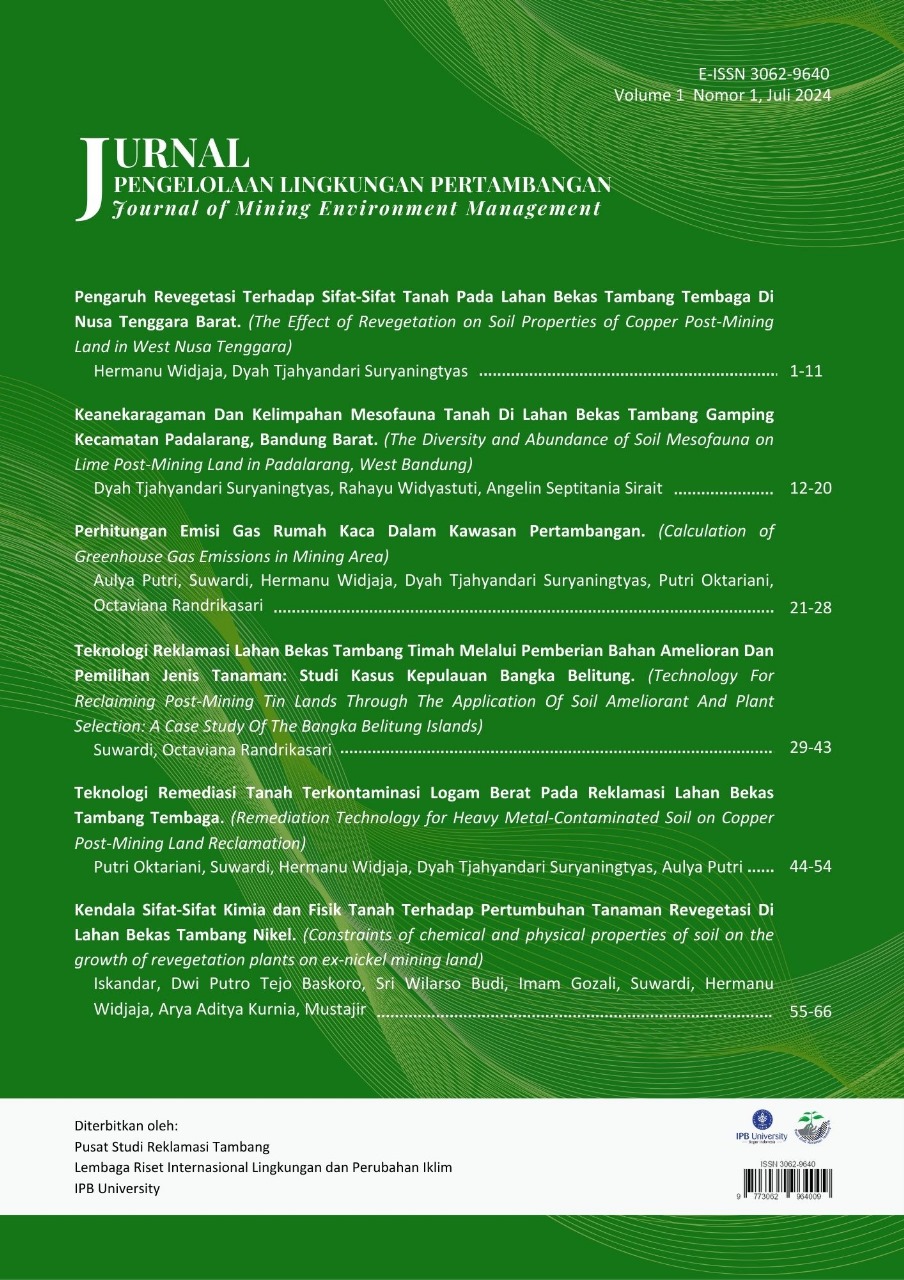Calculation of Greenhouse Gas Emissions in Mining Area
DOI:
https://doi.org/10.70191/jplp.v1i1.55151Keywords:
Deforestation, Greenhouse Gas Emission, Mining Industry, Non-renewable EnergyAbstract
Carbon emissions are one of the components of greenhouse gas (GHG) emissions in the form of carbon dioxide (CO2) which mainly comes from the use of fossil fuels and various human activities. Based on fossil fuel and industrial emissions data, in 2022 Indonesia ranked as the 6th largest carbon emitting country in the world after China, the United States, India, Russia and Japan, with 728.88 million tons of CO2e total emissions. The Ministry of Industry reported that total GHG emissions from Indonesia's industrial sector reached 238.1 million tons of CO2e in 2022. In the mining industry, GHG emissions originate from deforestation, energy use, processing, and refining, with non-renewable energy use being the largest emitter. GHG emissions from primary mineral and metal production contribute approximately 10% of global GHG emissions related to energy. Each mining industry may have varying primary sources of GHG emissions depending on the type of mine and the final product. Mining industries, as one of the major emitters, must conduct GHG inventories to understand emission sources and develop effective reduction strategies. GHG inventory activities are conducted based on guidelines provided by the Ministry of Environment and Forestry's National Greenhouse Gas Inventory Management Handbook (2012), Book II Volumes 1-4. Efforts to reduce GHG emissions can be undertaken through planting plants that have high carbon absorption and storage capabilities in mine reclamation activities, as well as using New and Renewable Energy (NRE) as an alternative to replace fossil energy.
References
Aramendia, E., Brockway, P. E., Taylor, P. G., & Norman, J. (2023). Global energy consumption of the mineral mining industry: Exploring the historical perspective and future pathways to 2060. Global Environmental Change, 83, 102745. https://doi.org/10.1016/j.gloenvcha.2023.102745.
Bellois, G. (2022). The Impacts of Climate Change on the Mining Sector. International Institute for Sustainable Development. https://www.iisd.org/publications/brief/impacts-climate-change-mining-sector.
[BPS] Badan Pusat Statistik Indonesia. (2024). Angka Deforestasi (Netto) Indonesia di Dalam dan di Luar Kawasan Hutan Tahun 2013-2022 (Ha/Th)—Tabel Statistik. https://www.bps.go.id/id/statistics-table/1/MjA4MSMx/angka-deforestasi--netto--indonesia-di-dalam-dan-di-luar-kawasan-hutan-tahun-2013-2022--ha-th-.html.
Cebrucean, D., Cebrucean, V., & Ionel, I. (2014). CO2 Capture and Storage from Fossil Fuel Power Plants. Energy Procedia, 63, 18–26. https://doi.org/10.1016/j.egypro.2014.11.003.
Chaddad, F., Mello, F. A. O., Tayebi, M., Safanelli, J. L., Campos, L. R., Amorim, M. T. A., Barbosa de Sousa, G. P., Ferreira, T. O., Ruiz, F., Perlatti, F., Greschuk, L. T., Rosin, N. A., Fim Rosas, J. T., & Demattê, J. A. M. (2022). Impact of mining-induced deforestation on soil surface temperature and carbon stocks: A case study using remote sensing in the Amazon rainforest. Journal of South American Earth Sciences, 119, 103983. https://doi.org/10.1016/j.jsames.2022.103983.
Cox, B., Innis, S., Kunz, N. C., & Steen, J. (2022). The mining industry as a net beneficiary of a global tax on carbon emissions. Communications Earth & Environment, 3(1), 1–8. https://doi.org/10.1038/s43247-022-00346-4.
Csillik, O., Kumar, P., Mascaro, J., O’Shea, T., & Asner, G. P. (2019). Monitoring tropical forest carbon stocks and emissions using Planet satellite data. Scientific Reports, 9(1), 17831. https://doi.org/10.1038/s41598-019-54386-6.
Dahlan, E. N. (2008). Jumlah emisi gas CO2 dan pemilihan jenis tanaman berdaya rosot sangat tinggi: Studi kasus di Kota Bogor. Media Konservasi, 13(2), 231466. https://doi.org/10.29243/medkon.13.2.%p.
Djaenudin, D., Oktaviani, R., Hartoyo, S., & Dwiprabowo, H. (2018). Analisis peluang keberhasilan penurunan laju deforestasi pendekatan teori transisi hutan. Jurnal Penelitian Sosial Dan Ekonomi Kehutanan, 15(1), 15–29. https://doi.org/10.20886/jpsek.2018.15.1.15-29.
Huo, D., Sari, Y. A., Kealey, R., & Zhang, Q. (2023). Reinforcement learning-based fleet dispatching for greenhouse gas emission reduction in open-pit mining operations. Resources, Conservation and Recycling, 188, 106664. https://doi.org/10.1016/j.resconrec.2022.106664.
Igogo, T., Awuah-Offei, K., Newman, A., Lowder, T., & Engel-Cox, J. (2021). Integrating renewable energy into mining operations: Opportunities, challenges, and enabling approaches. Applied Energy, 300, 117375. https://doi.org/10.1016/j.apenergy.2021.117375.
Ijazah, M., & Sancayaningsih, R. P. (2015). Penyimpanan Karbon pada Tegakan Pinus merkusii dan Acacia auriculiformis di Hutan Lindung Mangunan, Dlingo, Bantul, Daerah Istimewa Yogyakarta [Seminar Nasional XII Pendidikan Biologi FKIP UNS 2015]. Universitas Sebelas Maret.
KLHK. (2012). Pedoman Penyelenggaraan Inventarisasi Gas Rumah Kaca Nasional Kementerian Lingkungan Hidup dan Kehutanan (Vols. 1–4). Jakarta: Kementerian Lingkungan Hidup.
KLHK. (2024). Sistem Inventarisasi Gas Rumah Kaca Nasional. Jakarta: Kementerian Lingkungan Hidup. https://signsmart.menlhk.go.id/v2.1/app/.
Liun, E., & Sunardi, S. (2014). Perbandingan harga energi dari sumber energi baru terbarukan dan fosil. Jurnal Pengembangan Energi Nuklir, 16(2), Article 2. https://doi.org/10.17146/jpen.2014.16.2.2521.
Momongan, J. F., Gosal, P. H., & Kumurur, V. (2017). Efektivitas jalur hijau dalam menyerap emisi gas rumah kaca di Kota Manado. SPASIAL, 4(1), Article 1. https://doi.org/10.35793/sp.v4i1.14869.
Norgate, T., & Haque, N. (2010). Energy and greenhouse gas impacts of mining and mineral processing operations. Journal of Cleaner Production, 18(3), 266–274. https://doi.org/10.1016/j.jclepro.2009.09.020.
Pouresmaieli, M., Ataei, M., Nouri Qarahasanlou, A., & Barabadi, A. (2023). Integration of renewable energy and sustainable development with strategic planning in the mining industry. Results in Engineering, 20, 101412. https://doi.org/10.1016/j.rineng.2023.101412.
Pramudiyanto, A. S., & Suedy, S. W. A. (2020). Energi Bersih dan ramah lingkungan dari biomassa untuk mengurangi efek gas rumah kaca dan perubahan iklim yang ekstrim. Jurnal Energi Baru dan Terbarukan, 1(3), 86–99. https://doi.org/10.14710/jebt.2020.9990.
Ritchie, H., Roser, M., & Rosado, P. (2020, May 11). CO₂ and Greenhouse Gas Emissions. Our World in Data. https://ourworldindata.org/co2/country/indonesia.
Setyono, J. S., Mardiansjah, F. H., & Astuti, M. F. K. (2019). Potensi pengembangan energi baru dan energi terbarukan di Kota Semarang. Jurnal Riptek, 13(2), 177–186.













